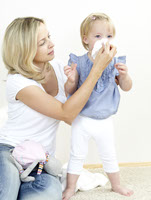Allergy and Rhinosinusitis

Allergies can cause many ear, nose, and throat symptoms in children, but allergies can be difficult to separate from other causes. Nasal allergy symptoms can include nasal obstruction, runny nose, sneezing, post-nasal drip and cough. Children with nasal allergies often have a history of other allergic tendencies (or atopy). These may include early food allergies or atopic dermatitis in infancy. Children with nasal allergies are at higher risk for developing Asthma. Fatigue can be a common and debilitating allergy symptom. Allergies may also play a role in chronic or recurring ear infections, particularly in older children. Diagnosing and treating allergies can be an important part treating various pediatric ear, nose and throat problems.
In children, the sinuses are not fully developed until late in the teen years. Although small, the maxillary (behind the cheek) and ethmoid (between the eyes) sinuses are present at birth. Unlike in adults, pediatric sinusitis is difficult to diagnose because symptoms of sinusitis can be caused by other problems, such as viral illness and allergy.
The following symptoms may indicate a sinus infection in your child:
- a “cold” lasting more than 10 to 14 days, sometimes with a low-grade fever
- thick yellow-green nasal drainage
- post-nasal drip, sometimes leading to or exhibited as sore throat, cough, bad breath, nausea and/or vomiting
- headache, usually in children age six or older
- irritability or fatigue
- swelling around the eyes.
Young children are more prone to infections of the nose, sinus, and ears, especially in the first several years of life. These are most frequently caused by viral infections (colds), and can also be aggravated by allergies, exposure to tobacco smoke and pollutants, enrollment in day care and presence of laryngopharyngeal reflux (reflux of stomach acid into the throat).
Sinusitis in children presents differently than sinusitis in adults. Children more often demonstrate a cough, bad breath, crankiness, low energy, and swelling around the eyes, along with a thick yellow-green nasal or post-nasal drip. Once the diagnosis of sinusitis has been made, children are successfully treated with antibiotic therapy in most cases. In the rare child where medical therapy fails, surgical therapy can be used as a safe and effective method of treating sinus disease in children.
Removal of adenoid tissue (lymphoid tissue behind the nose) can be an effective treatment for patients presenting with recurring sinusitis or chronic runny nose, congestion, post-nasal drip, bad breath, cough and headache. Adenoid tissue can obstruct the back of the nose and impair the clearing of nasal secretions, and may harbor bacteria (adenoiditis) causing recurring or chronic sinus infections.
In a very small percentage of patients, sinus surgery may be considered for recurring or persistent sinusitis symptoms despite medical therapy (antibiotics, allergy and/or reflux treatment) and adenoidectomy. Using an instrument called an endoscope, the surgeon opens the natural drainage pathways of your child’s sinuses and makes the narrow passages wider. This also allows for obtaining cultures so that antibiotics can be directed against the specific bacteria causing the sinus infection. Improving sinus ventilation and drainage usually results in a reduction in the number and severity of sinus infections.
